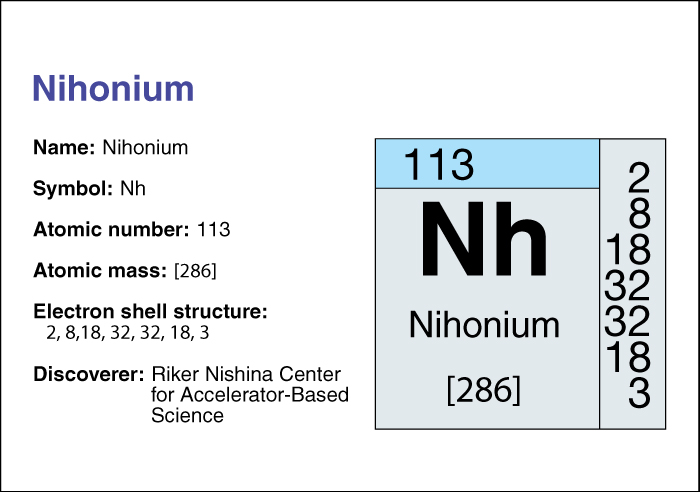Nihonium << `NY ` hoh nee uhm >> is an artificially produced radioactive chemical element. It has anatomic number (number of protons) of 113.

Nihonium has the chemical symbol Nh. Chemists place nihonium in the transactinide group of transuranium elements. For information on the position of nihonium on the periodic table, see the article Periodic table.
In 2004, the creation of the first atom of element 113 was announced by Japanese physicists and chemists working at the Rikagaku Kenkyusho (RIKEN) Nishina Center for Accelerator-Based Science in Wako (near Tokyo), Japan. But the International Union of Pure and Applied Chemistry (IUPAC) did not find their evidence conclusive enough to confirm the discovery. IUPAC is the recognized authority in crediting the discovery of elements and assigning names to them. Furthermore, discovery of the element was also claimed by a group from the Joint Institute for Nuclear Research in Dubna (near Moscow), Russia, and the Lawrence Livermore National Laboratory in Livermore, California. The team from Japan continued to experiment, producing two more atoms of the element. In 2015, IUPAC assigned credit for the discovery of the element to the Japanese team. Element 113 was officially named nihonium in 2016. Its name includes the word Nihon, which means Japan in Japanese, in honor of the country of discovery. Nihonium is the first chemical element credited to discoverers in Asia.
The first atom of nihonium produced had an atomic mass number (total number of protons and neutrons) of 278 and decayed (broke apart) in less than a millisecond. Other more stable isotopes were created later. Isotopes are forms of a chemical element with the same number of protons but different numbers of neutrons. The scientists created nihonium in a device known as a particle accelerator. They bombarded the element bismuth, which has an atomic number of 83, with zinc, atomic number 30.
The researchers estimated that the half-life of isotope 286, the longest-lived isotope of nihonium, is approximately 20 seconds—that is, due to radioactive decay, only half the atoms in a sample of isotope 286 would still be atoms of that isotope after about 20 seconds. To determine an isotope’s half-life with much accuracy, scientists must study many atoms of the isotope. When only a few atoms have been detected—as in the case of isotope 286—they can obtain only an approximate value of the half-life.
In the periodic table of the elements, nihonium is included with Group 13 (3A), a family of elements that includes boron and aluminum. Elements in the same family group have related properties because they have the same arrangement of electrons in their outermost or valence shell. Scientists can predict some of the properties of nihonium from its position in the periodic table. However, it is not possible to confirm these predictions without obtaining many more atoms of the element.
